Networking Fundamentals Assignment: Protocols, Cables, and Connections
VerifiedAdded on 2021/06/14
|10
|1942
|200
Homework Assignment
AI Summary
This document presents a comprehensive solution to a Networking Fundamentals assignment, addressing key concepts in network architecture and communication. The assignment begins by exploring the importance of networking standards, specifically focusing on interoperability and the role of standards in product development and market compatibility. It then delves into a comparative analysis of the OSI, DoD, and TCP/IP network models, highlighting their structures and functionalities. The solution proceeds to examine different types of network cables, including twisted pair, coaxial, fiber optic, and wireless technologies, discussing their characteristics and applications. Finally, the assignment concludes by explaining synchronous connections, their advantages, and their role in data transmission. The document includes diagrams to illustrate the different network models and cable types, and provides a list of references for further reading.
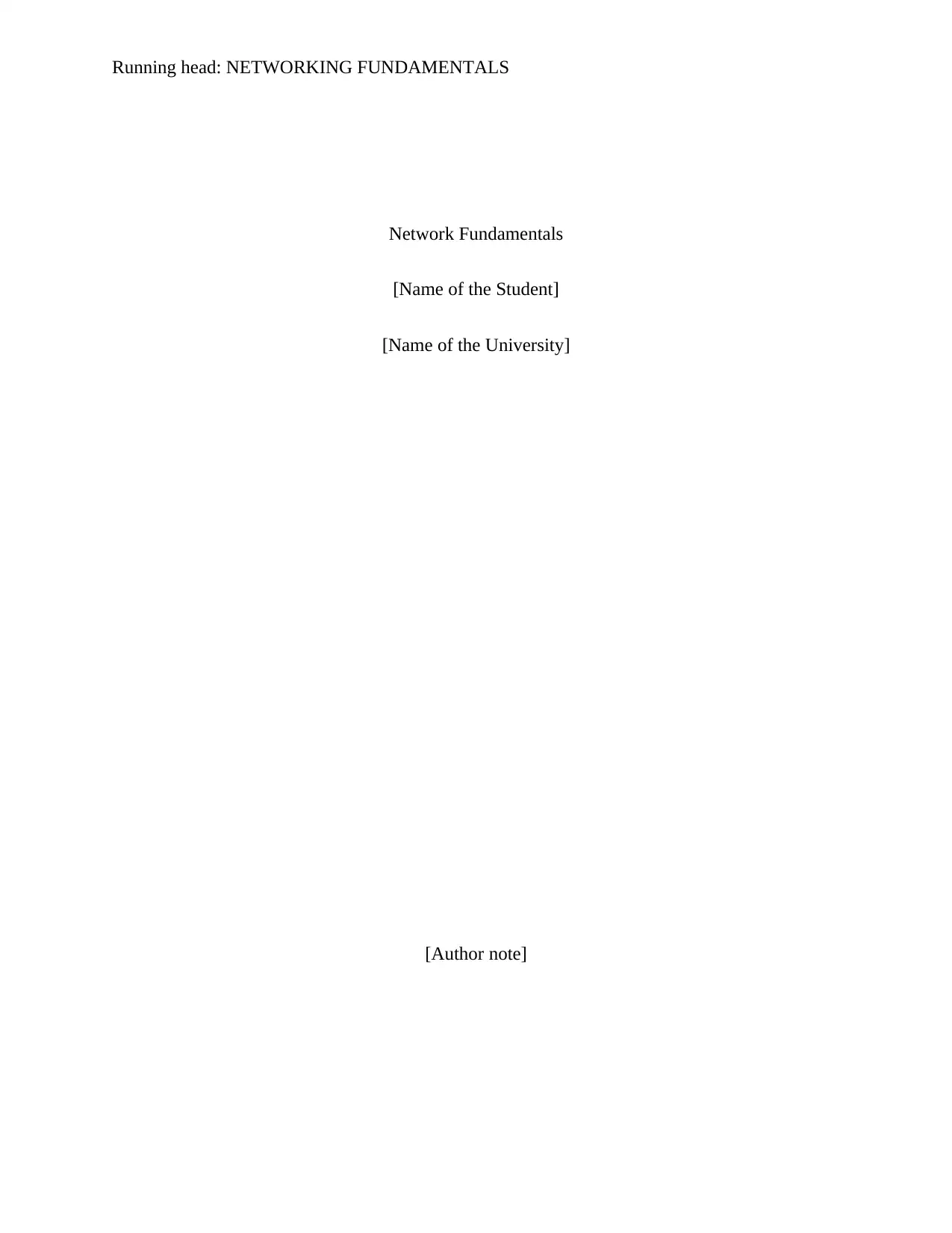
Running head: NETWORKING FUNDAMENTALS
Network Fundamentals
[Name of the Student]
[Name of the University]
[Author note]
Network Fundamentals
[Name of the Student]
[Name of the University]
[Author note]
Paraphrase This Document
Need a fresh take? Get an instant paraphrase of this document with our AI Paraphraser
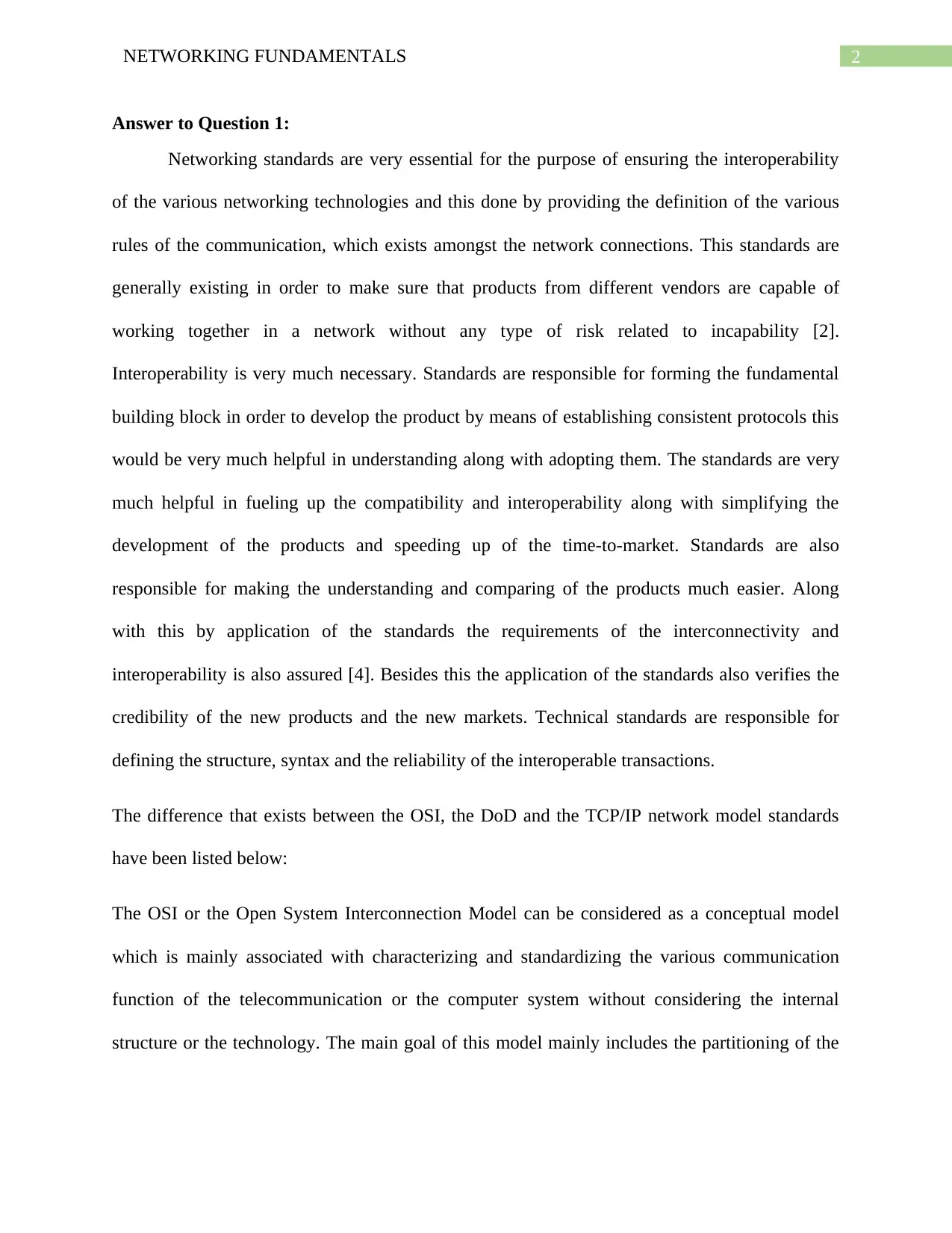
2NETWORKING FUNDAMENTALS
Answer to Question 1:
Networking standards are very essential for the purpose of ensuring the interoperability
of the various networking technologies and this done by providing the definition of the various
rules of the communication, which exists amongst the network connections. This standards are
generally existing in order to make sure that products from different vendors are capable of
working together in a network without any type of risk related to incapability [2].
Interoperability is very much necessary. Standards are responsible for forming the fundamental
building block in order to develop the product by means of establishing consistent protocols this
would be very much helpful in understanding along with adopting them. The standards are very
much helpful in fueling up the compatibility and interoperability along with simplifying the
development of the products and speeding up of the time-to-market. Standards are also
responsible for making the understanding and comparing of the products much easier. Along
with this by application of the standards the requirements of the interconnectivity and
interoperability is also assured [4]. Besides this the application of the standards also verifies the
credibility of the new products and the new markets. Technical standards are responsible for
defining the structure, syntax and the reliability of the interoperable transactions.
The difference that exists between the OSI, the DoD and the TCP/IP network model standards
have been listed below:
The OSI or the Open System Interconnection Model can be considered as a conceptual model
which is mainly associated with characterizing and standardizing the various communication
function of the telecommunication or the computer system without considering the internal
structure or the technology. The main goal of this model mainly includes the partitioning of the
Answer to Question 1:
Networking standards are very essential for the purpose of ensuring the interoperability
of the various networking technologies and this done by providing the definition of the various
rules of the communication, which exists amongst the network connections. This standards are
generally existing in order to make sure that products from different vendors are capable of
working together in a network without any type of risk related to incapability [2].
Interoperability is very much necessary. Standards are responsible for forming the fundamental
building block in order to develop the product by means of establishing consistent protocols this
would be very much helpful in understanding along with adopting them. The standards are very
much helpful in fueling up the compatibility and interoperability along with simplifying the
development of the products and speeding up of the time-to-market. Standards are also
responsible for making the understanding and comparing of the products much easier. Along
with this by application of the standards the requirements of the interconnectivity and
interoperability is also assured [4]. Besides this the application of the standards also verifies the
credibility of the new products and the new markets. Technical standards are responsible for
defining the structure, syntax and the reliability of the interoperable transactions.
The difference that exists between the OSI, the DoD and the TCP/IP network model standards
have been listed below:
The OSI or the Open System Interconnection Model can be considered as a conceptual model
which is mainly associated with characterizing and standardizing the various communication
function of the telecommunication or the computer system without considering the internal
structure or the technology. The main goal of this model mainly includes the partitioning of the
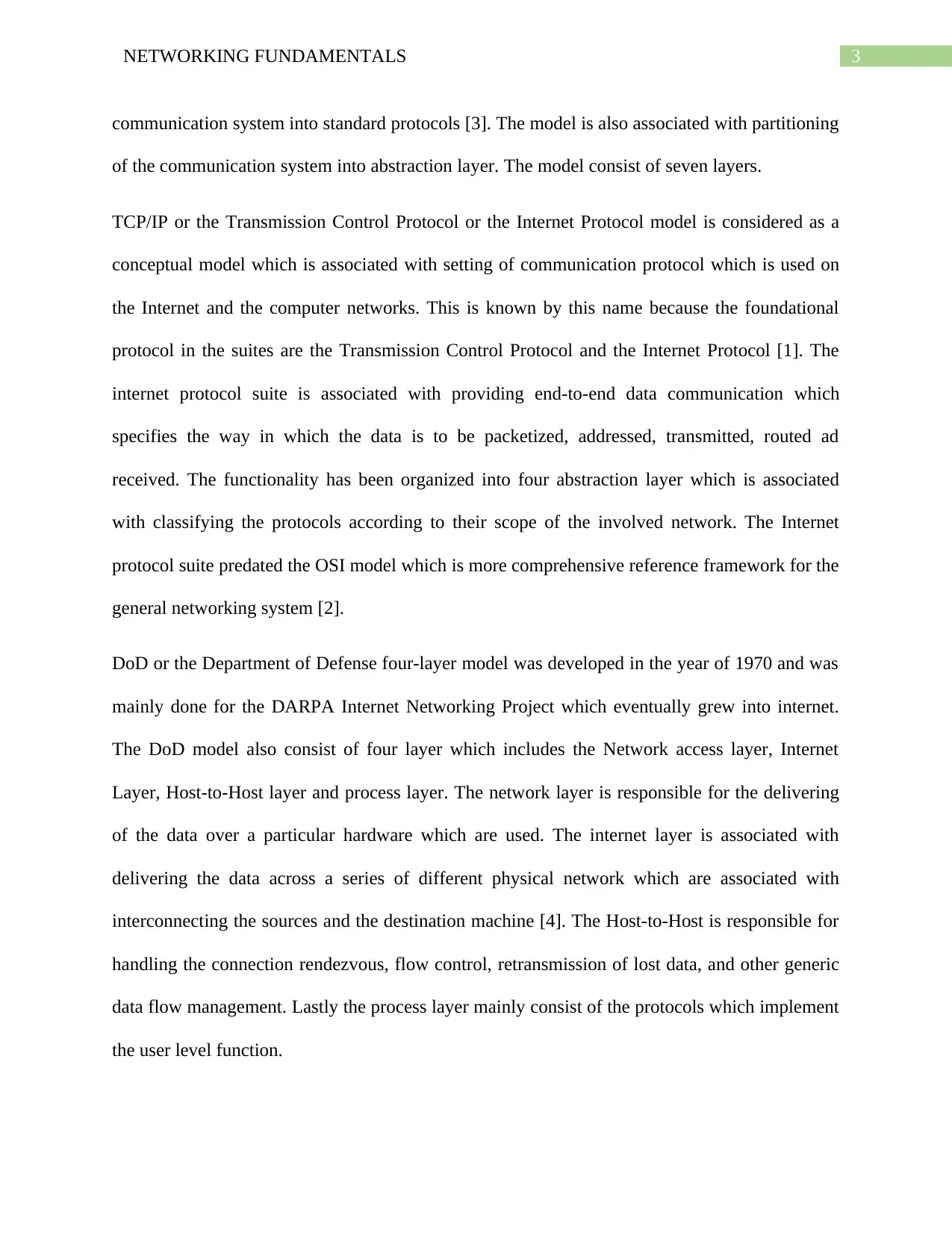
3NETWORKING FUNDAMENTALS
communication system into standard protocols [3]. The model is also associated with partitioning
of the communication system into abstraction layer. The model consist of seven layers.
TCP/IP or the Transmission Control Protocol or the Internet Protocol model is considered as a
conceptual model which is associated with setting of communication protocol which is used on
the Internet and the computer networks. This is known by this name because the foundational
protocol in the suites are the Transmission Control Protocol and the Internet Protocol [1]. The
internet protocol suite is associated with providing end-to-end data communication which
specifies the way in which the data is to be packetized, addressed, transmitted, routed ad
received. The functionality has been organized into four abstraction layer which is associated
with classifying the protocols according to their scope of the involved network. The Internet
protocol suite predated the OSI model which is more comprehensive reference framework for the
general networking system [2].
DoD or the Department of Defense four-layer model was developed in the year of 1970 and was
mainly done for the DARPA Internet Networking Project which eventually grew into internet.
The DoD model also consist of four layer which includes the Network access layer, Internet
Layer, Host-to-Host layer and process layer. The network layer is responsible for the delivering
of the data over a particular hardware which are used. The internet layer is associated with
delivering the data across a series of different physical network which are associated with
interconnecting the sources and the destination machine [4]. The Host-to-Host is responsible for
handling the connection rendezvous, flow control, retransmission of lost data, and other generic
data flow management. Lastly the process layer mainly consist of the protocols which implement
the user level function.
communication system into standard protocols [3]. The model is also associated with partitioning
of the communication system into abstraction layer. The model consist of seven layers.
TCP/IP or the Transmission Control Protocol or the Internet Protocol model is considered as a
conceptual model which is associated with setting of communication protocol which is used on
the Internet and the computer networks. This is known by this name because the foundational
protocol in the suites are the Transmission Control Protocol and the Internet Protocol [1]. The
internet protocol suite is associated with providing end-to-end data communication which
specifies the way in which the data is to be packetized, addressed, transmitted, routed ad
received. The functionality has been organized into four abstraction layer which is associated
with classifying the protocols according to their scope of the involved network. The Internet
protocol suite predated the OSI model which is more comprehensive reference framework for the
general networking system [2].
DoD or the Department of Defense four-layer model was developed in the year of 1970 and was
mainly done for the DARPA Internet Networking Project which eventually grew into internet.
The DoD model also consist of four layer which includes the Network access layer, Internet
Layer, Host-to-Host layer and process layer. The network layer is responsible for the delivering
of the data over a particular hardware which are used. The internet layer is associated with
delivering the data across a series of different physical network which are associated with
interconnecting the sources and the destination machine [4]. The Host-to-Host is responsible for
handling the connection rendezvous, flow control, retransmission of lost data, and other generic
data flow management. Lastly the process layer mainly consist of the protocols which implement
the user level function.
⊘ This is a preview!⊘
Do you want full access?
Subscribe today to unlock all pages.

Trusted by 1+ million students worldwide
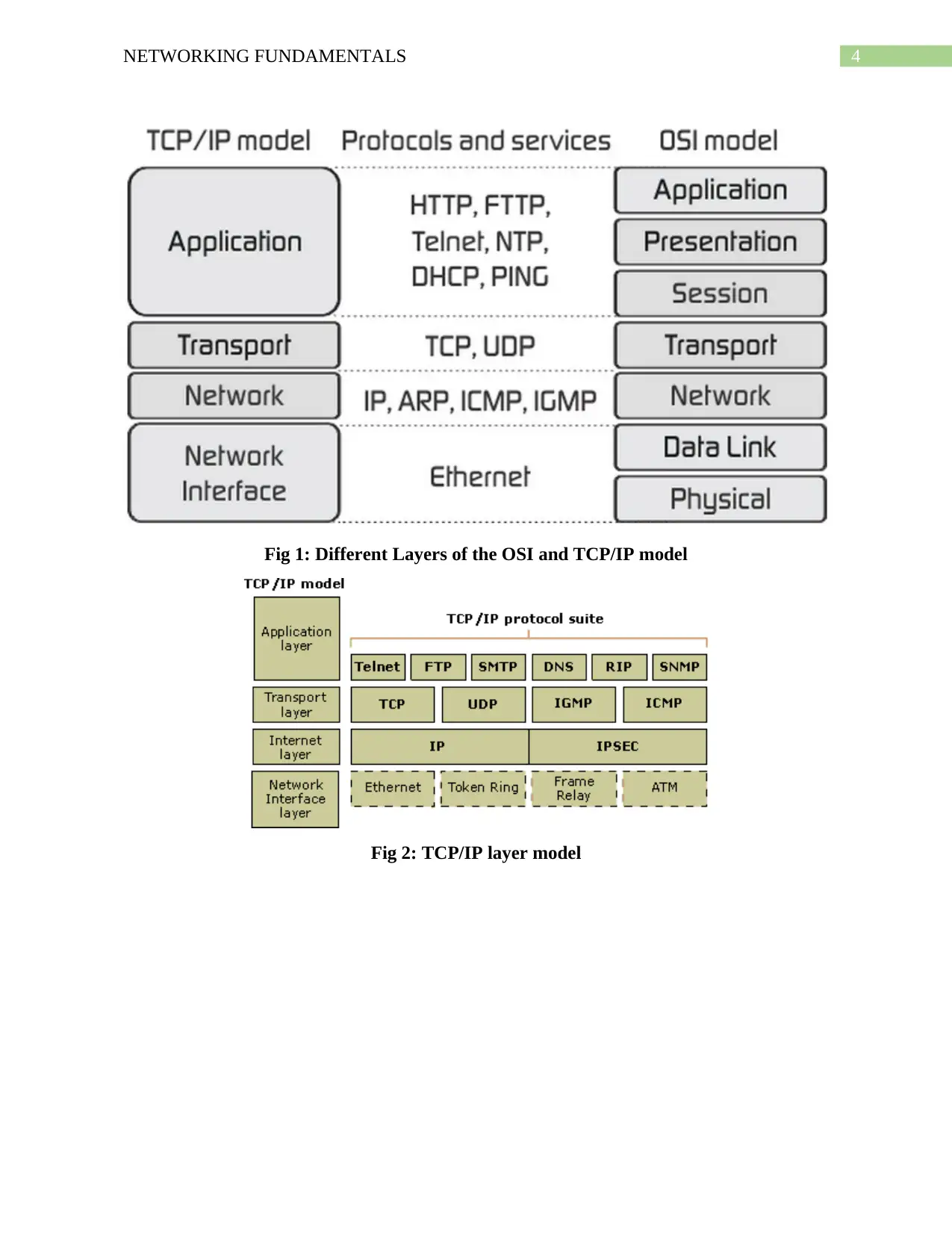
4NETWORKING FUNDAMENTALS
Fig 1: Different Layers of the OSI and TCP/IP model
Fig 2: TCP/IP layer model
Fig 1: Different Layers of the OSI and TCP/IP model
Fig 2: TCP/IP layer model
Paraphrase This Document
Need a fresh take? Get an instant paraphrase of this document with our AI Paraphraser
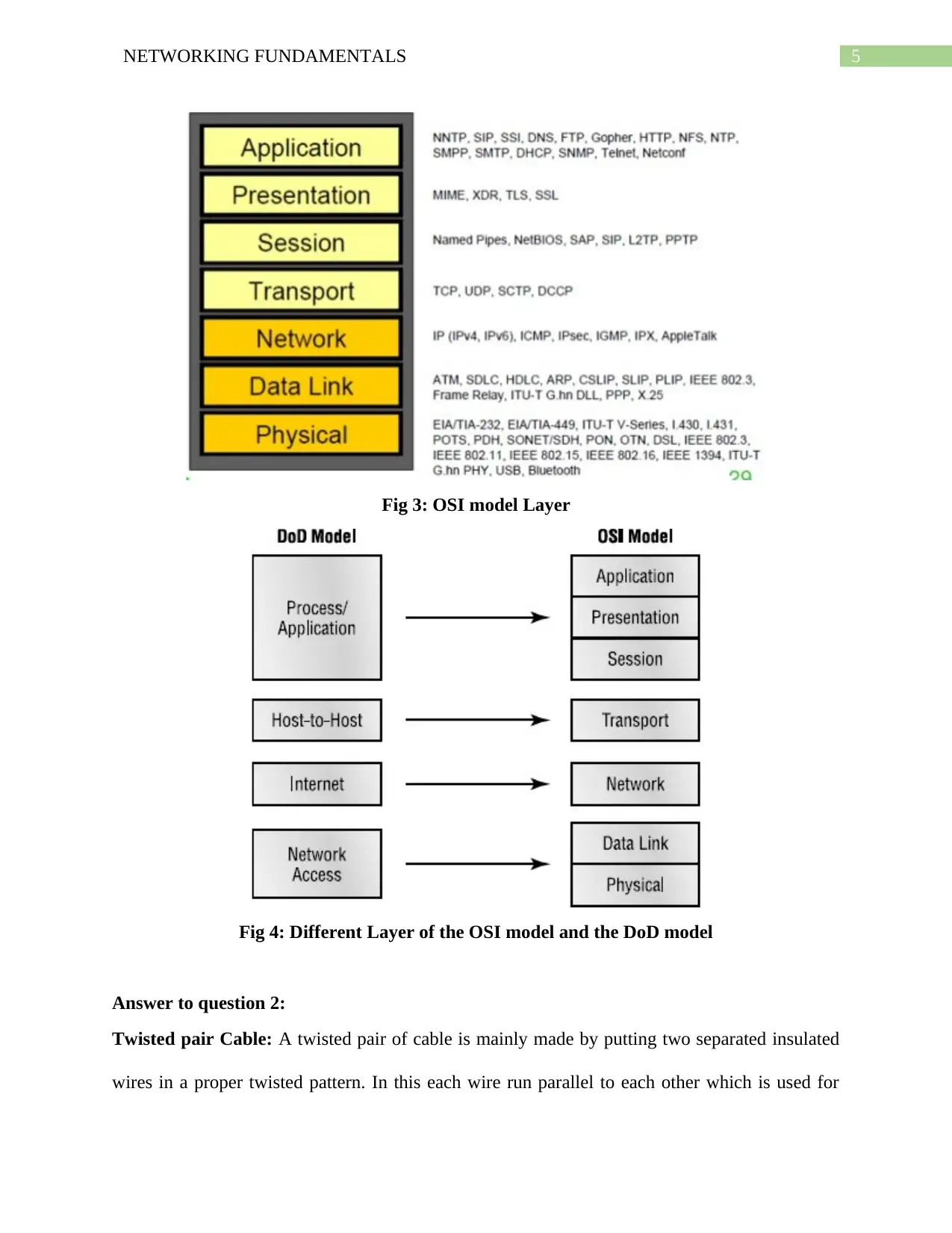
5NETWORKING FUNDAMENTALS
Fig 3: OSI model Layer
Fig 4: Different Layer of the OSI model and the DoD model
Answer to question 2:
Twisted pair Cable: A twisted pair of cable is mainly made by putting two separated insulated
wires in a proper twisted pattern. In this each wire run parallel to each other which is used for
Fig 3: OSI model Layer
Fig 4: Different Layer of the OSI model and the DoD model
Answer to question 2:
Twisted pair Cable: A twisted pair of cable is mainly made by putting two separated insulated
wires in a proper twisted pattern. In this each wire run parallel to each other which is used for
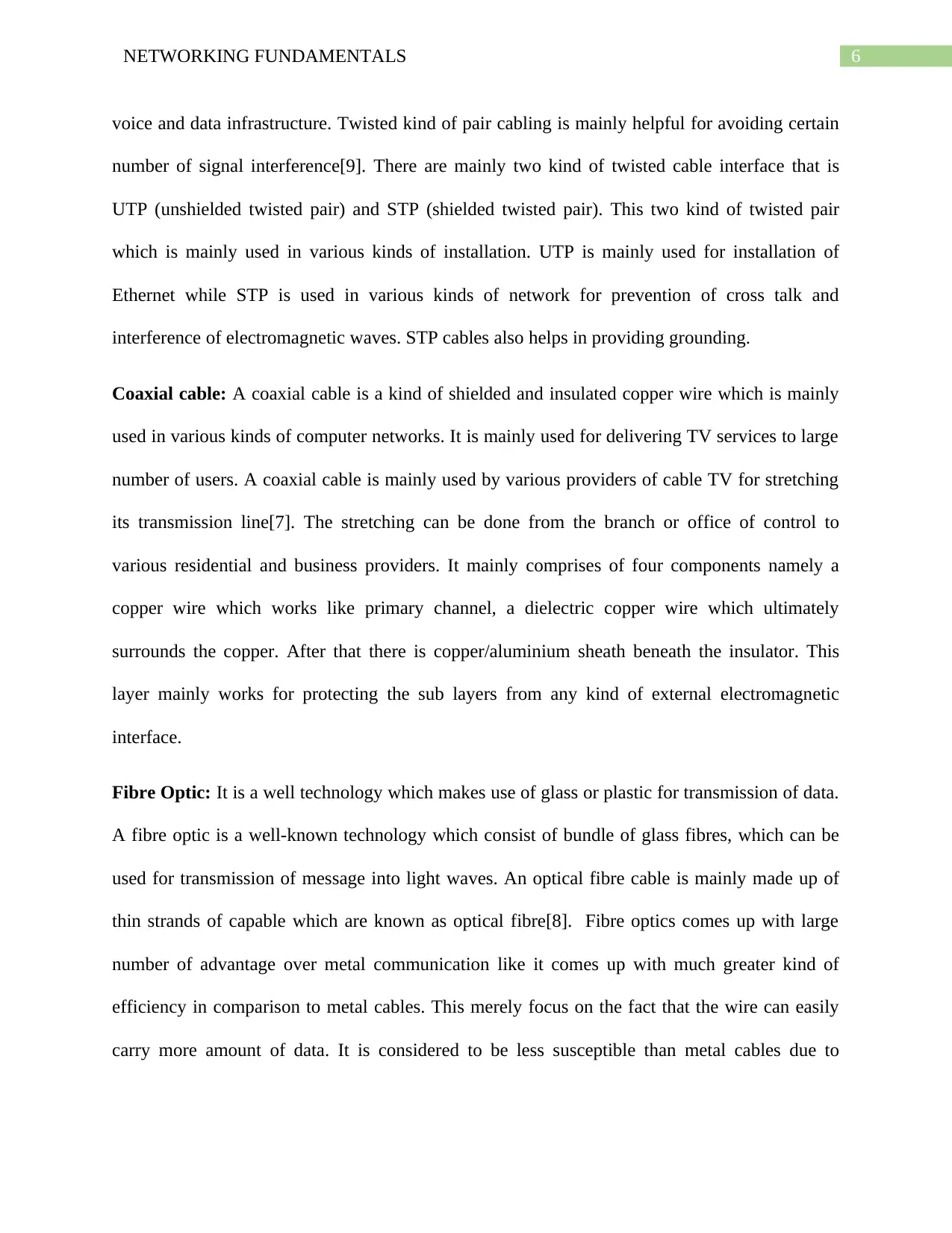
6NETWORKING FUNDAMENTALS
voice and data infrastructure. Twisted kind of pair cabling is mainly helpful for avoiding certain
number of signal interference[9]. There are mainly two kind of twisted cable interface that is
UTP (unshielded twisted pair) and STP (shielded twisted pair). This two kind of twisted pair
which is mainly used in various kinds of installation. UTP is mainly used for installation of
Ethernet while STP is used in various kinds of network for prevention of cross talk and
interference of electromagnetic waves. STP cables also helps in providing grounding.
Coaxial cable: A coaxial cable is a kind of shielded and insulated copper wire which is mainly
used in various kinds of computer networks. It is mainly used for delivering TV services to large
number of users. A coaxial cable is mainly used by various providers of cable TV for stretching
its transmission line[7]. The stretching can be done from the branch or office of control to
various residential and business providers. It mainly comprises of four components namely a
copper wire which works like primary channel, a dielectric copper wire which ultimately
surrounds the copper. After that there is copper/aluminium sheath beneath the insulator. This
layer mainly works for protecting the sub layers from any kind of external electromagnetic
interface.
Fibre Optic: It is a well technology which makes use of glass or plastic for transmission of data.
A fibre optic is a well-known technology which consist of bundle of glass fibres, which can be
used for transmission of message into light waves. An optical fibre cable is mainly made up of
thin strands of capable which are known as optical fibre[8]. Fibre optics comes up with large
number of advantage over metal communication like it comes up with much greater kind of
efficiency in comparison to metal cables. This merely focus on the fact that the wire can easily
carry more amount of data. It is considered to be less susceptible than metal cables due to
voice and data infrastructure. Twisted kind of pair cabling is mainly helpful for avoiding certain
number of signal interference[9]. There are mainly two kind of twisted cable interface that is
UTP (unshielded twisted pair) and STP (shielded twisted pair). This two kind of twisted pair
which is mainly used in various kinds of installation. UTP is mainly used for installation of
Ethernet while STP is used in various kinds of network for prevention of cross talk and
interference of electromagnetic waves. STP cables also helps in providing grounding.
Coaxial cable: A coaxial cable is a kind of shielded and insulated copper wire which is mainly
used in various kinds of computer networks. It is mainly used for delivering TV services to large
number of users. A coaxial cable is mainly used by various providers of cable TV for stretching
its transmission line[7]. The stretching can be done from the branch or office of control to
various residential and business providers. It mainly comprises of four components namely a
copper wire which works like primary channel, a dielectric copper wire which ultimately
surrounds the copper. After that there is copper/aluminium sheath beneath the insulator. This
layer mainly works for protecting the sub layers from any kind of external electromagnetic
interface.
Fibre Optic: It is a well technology which makes use of glass or plastic for transmission of data.
A fibre optic is a well-known technology which consist of bundle of glass fibres, which can be
used for transmission of message into light waves. An optical fibre cable is mainly made up of
thin strands of capable which are known as optical fibre[8]. Fibre optics comes up with large
number of advantage over metal communication like it comes up with much greater kind of
efficiency in comparison to metal cables. This merely focus on the fact that the wire can easily
carry more amount of data. It is considered to be less susceptible than metal cables due to
⊘ This is a preview!⊘
Do you want full access?
Subscribe today to unlock all pages.

Trusted by 1+ million students worldwide
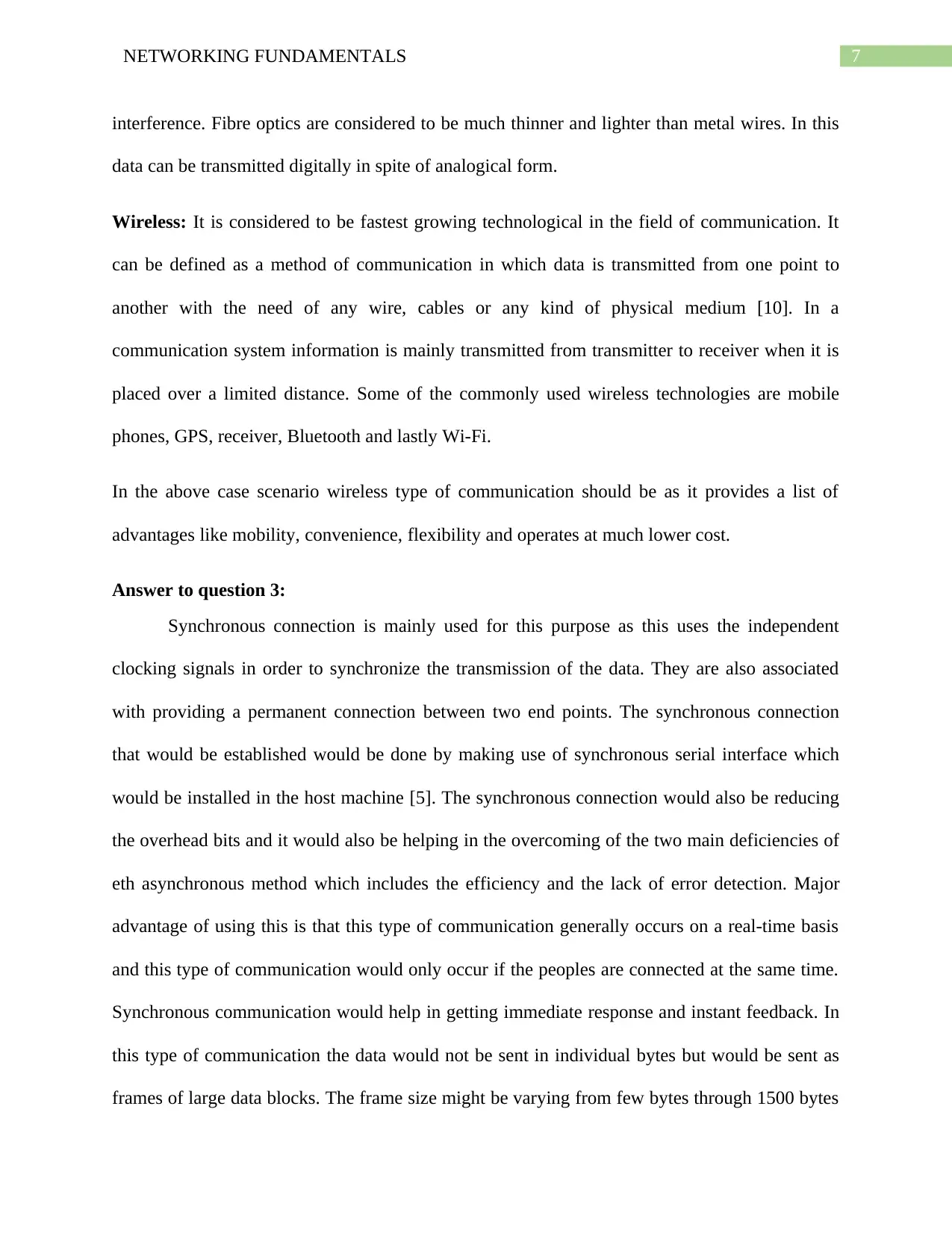
7NETWORKING FUNDAMENTALS
interference. Fibre optics are considered to be much thinner and lighter than metal wires. In this
data can be transmitted digitally in spite of analogical form.
Wireless: It is considered to be fastest growing technological in the field of communication. It
can be defined as a method of communication in which data is transmitted from one point to
another with the need of any wire, cables or any kind of physical medium [10]. In a
communication system information is mainly transmitted from transmitter to receiver when it is
placed over a limited distance. Some of the commonly used wireless technologies are mobile
phones, GPS, receiver, Bluetooth and lastly Wi-Fi.
In the above case scenario wireless type of communication should be as it provides a list of
advantages like mobility, convenience, flexibility and operates at much lower cost.
Answer to question 3:
Synchronous connection is mainly used for this purpose as this uses the independent
clocking signals in order to synchronize the transmission of the data. They are also associated
with providing a permanent connection between two end points. The synchronous connection
that would be established would be done by making use of synchronous serial interface which
would be installed in the host machine [5]. The synchronous connection would also be reducing
the overhead bits and it would also be helping in the overcoming of the two main deficiencies of
eth asynchronous method which includes the efficiency and the lack of error detection. Major
advantage of using this is that this type of communication generally occurs on a real-time basis
and this type of communication would only occur if the peoples are connected at the same time.
Synchronous communication would help in getting immediate response and instant feedback. In
this type of communication the data would not be sent in individual bytes but would be sent as
frames of large data blocks. The frame size might be varying from few bytes through 1500 bytes
interference. Fibre optics are considered to be much thinner and lighter than metal wires. In this
data can be transmitted digitally in spite of analogical form.
Wireless: It is considered to be fastest growing technological in the field of communication. It
can be defined as a method of communication in which data is transmitted from one point to
another with the need of any wire, cables or any kind of physical medium [10]. In a
communication system information is mainly transmitted from transmitter to receiver when it is
placed over a limited distance. Some of the commonly used wireless technologies are mobile
phones, GPS, receiver, Bluetooth and lastly Wi-Fi.
In the above case scenario wireless type of communication should be as it provides a list of
advantages like mobility, convenience, flexibility and operates at much lower cost.
Answer to question 3:
Synchronous connection is mainly used for this purpose as this uses the independent
clocking signals in order to synchronize the transmission of the data. They are also associated
with providing a permanent connection between two end points. The synchronous connection
that would be established would be done by making use of synchronous serial interface which
would be installed in the host machine [5]. The synchronous connection would also be reducing
the overhead bits and it would also be helping in the overcoming of the two main deficiencies of
eth asynchronous method which includes the efficiency and the lack of error detection. Major
advantage of using this is that this type of communication generally occurs on a real-time basis
and this type of communication would only occur if the peoples are connected at the same time.
Synchronous communication would help in getting immediate response and instant feedback. In
this type of communication the data would not be sent in individual bytes but would be sent as
frames of large data blocks. The frame size might be varying from few bytes through 1500 bytes
Paraphrase This Document
Need a fresh take? Get an instant paraphrase of this document with our AI Paraphraser
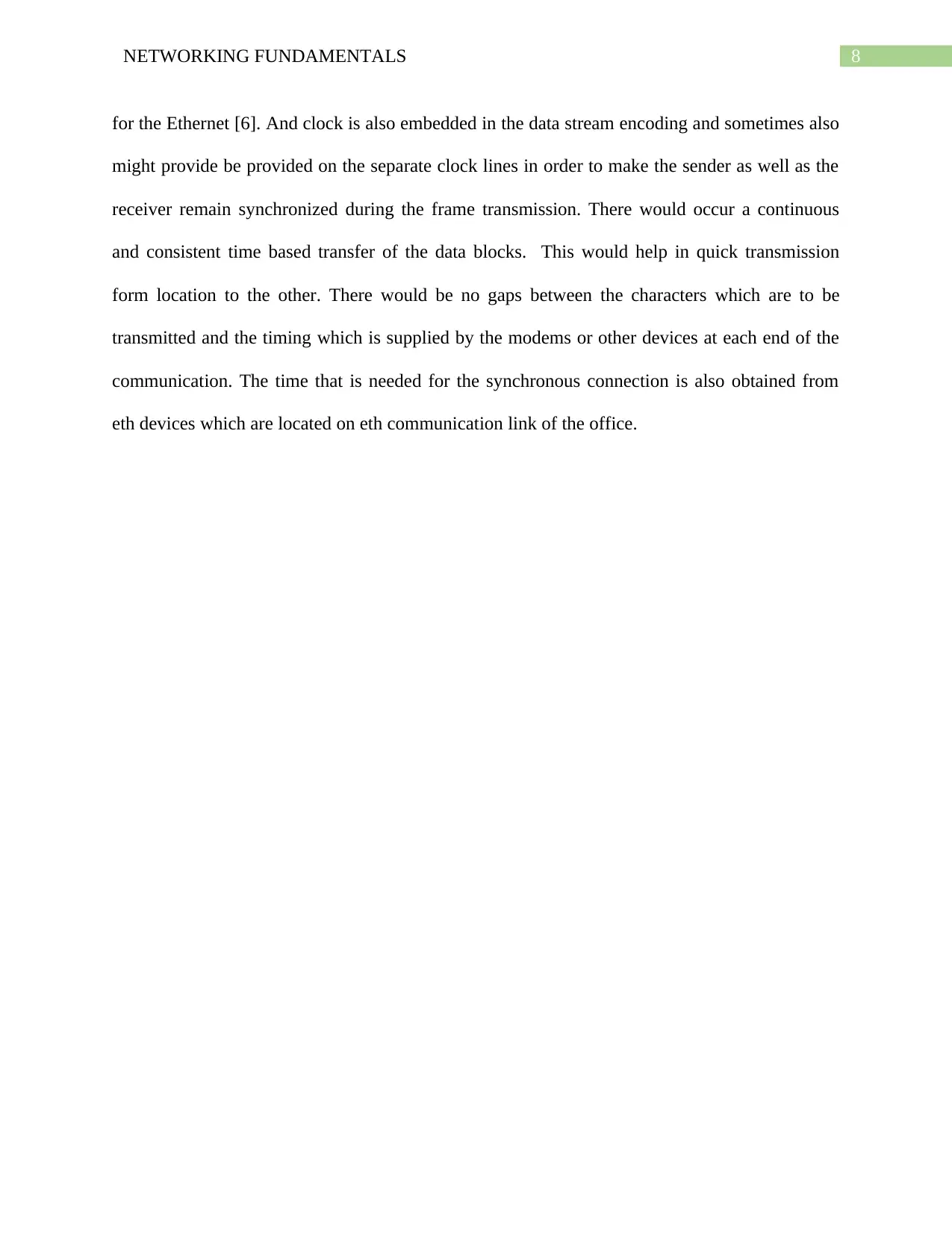
8NETWORKING FUNDAMENTALS
for the Ethernet [6]. And clock is also embedded in the data stream encoding and sometimes also
might provide be provided on the separate clock lines in order to make the sender as well as the
receiver remain synchronized during the frame transmission. There would occur a continuous
and consistent time based transfer of the data blocks. This would help in quick transmission
form location to the other. There would be no gaps between the characters which are to be
transmitted and the timing which is supplied by the modems or other devices at each end of the
communication. The time that is needed for the synchronous connection is also obtained from
eth devices which are located on eth communication link of the office.
for the Ethernet [6]. And clock is also embedded in the data stream encoding and sometimes also
might provide be provided on the separate clock lines in order to make the sender as well as the
receiver remain synchronized during the frame transmission. There would occur a continuous
and consistent time based transfer of the data blocks. This would help in quick transmission
form location to the other. There would be no gaps between the characters which are to be
transmitted and the timing which is supplied by the modems or other devices at each end of the
communication. The time that is needed for the synchronous connection is also obtained from
eth devices which are located on eth communication link of the office.
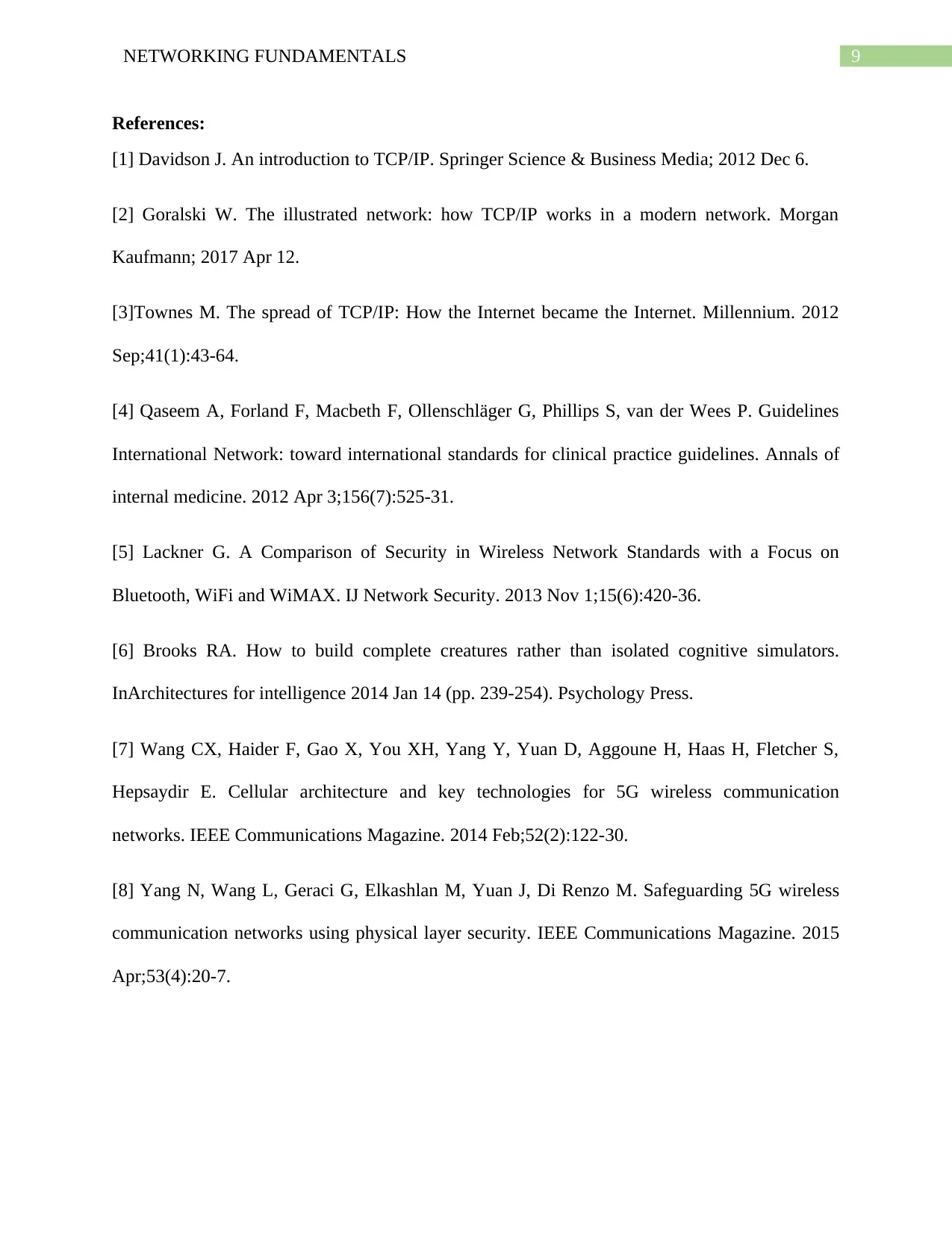
9NETWORKING FUNDAMENTALS
References:
[1] Davidson J. An introduction to TCP/IP. Springer Science & Business Media; 2012 Dec 6.
[2] Goralski W. The illustrated network: how TCP/IP works in a modern network. Morgan
Kaufmann; 2017 Apr 12.
[3]Townes M. The spread of TCP/IP: How the Internet became the Internet. Millennium. 2012
Sep;41(1):43-64.
[4] Qaseem A, Forland F, Macbeth F, Ollenschläger G, Phillips S, van der Wees P. Guidelines
International Network: toward international standards for clinical practice guidelines. Annals of
internal medicine. 2012 Apr 3;156(7):525-31.
[5] Lackner G. A Comparison of Security in Wireless Network Standards with a Focus on
Bluetooth, WiFi and WiMAX. IJ Network Security. 2013 Nov 1;15(6):420-36.
[6] Brooks RA. How to build complete creatures rather than isolated cognitive simulators.
InArchitectures for intelligence 2014 Jan 14 (pp. 239-254). Psychology Press.
[7] Wang CX, Haider F, Gao X, You XH, Yang Y, Yuan D, Aggoune H, Haas H, Fletcher S,
Hepsaydir E. Cellular architecture and key technologies for 5G wireless communication
networks. IEEE Communications Magazine. 2014 Feb;52(2):122-30.
[8] Yang N, Wang L, Geraci G, Elkashlan M, Yuan J, Di Renzo M. Safeguarding 5G wireless
communication networks using physical layer security. IEEE Communications Magazine. 2015
Apr;53(4):20-7.
References:
[1] Davidson J. An introduction to TCP/IP. Springer Science & Business Media; 2012 Dec 6.
[2] Goralski W. The illustrated network: how TCP/IP works in a modern network. Morgan
Kaufmann; 2017 Apr 12.
[3]Townes M. The spread of TCP/IP: How the Internet became the Internet. Millennium. 2012
Sep;41(1):43-64.
[4] Qaseem A, Forland F, Macbeth F, Ollenschläger G, Phillips S, van der Wees P. Guidelines
International Network: toward international standards for clinical practice guidelines. Annals of
internal medicine. 2012 Apr 3;156(7):525-31.
[5] Lackner G. A Comparison of Security in Wireless Network Standards with a Focus on
Bluetooth, WiFi and WiMAX. IJ Network Security. 2013 Nov 1;15(6):420-36.
[6] Brooks RA. How to build complete creatures rather than isolated cognitive simulators.
InArchitectures for intelligence 2014 Jan 14 (pp. 239-254). Psychology Press.
[7] Wang CX, Haider F, Gao X, You XH, Yang Y, Yuan D, Aggoune H, Haas H, Fletcher S,
Hepsaydir E. Cellular architecture and key technologies for 5G wireless communication
networks. IEEE Communications Magazine. 2014 Feb;52(2):122-30.
[8] Yang N, Wang L, Geraci G, Elkashlan M, Yuan J, Di Renzo M. Safeguarding 5G wireless
communication networks using physical layer security. IEEE Communications Magazine. 2015
Apr;53(4):20-7.
⊘ This is a preview!⊘
Do you want full access?
Subscribe today to unlock all pages.

Trusted by 1+ million students worldwide
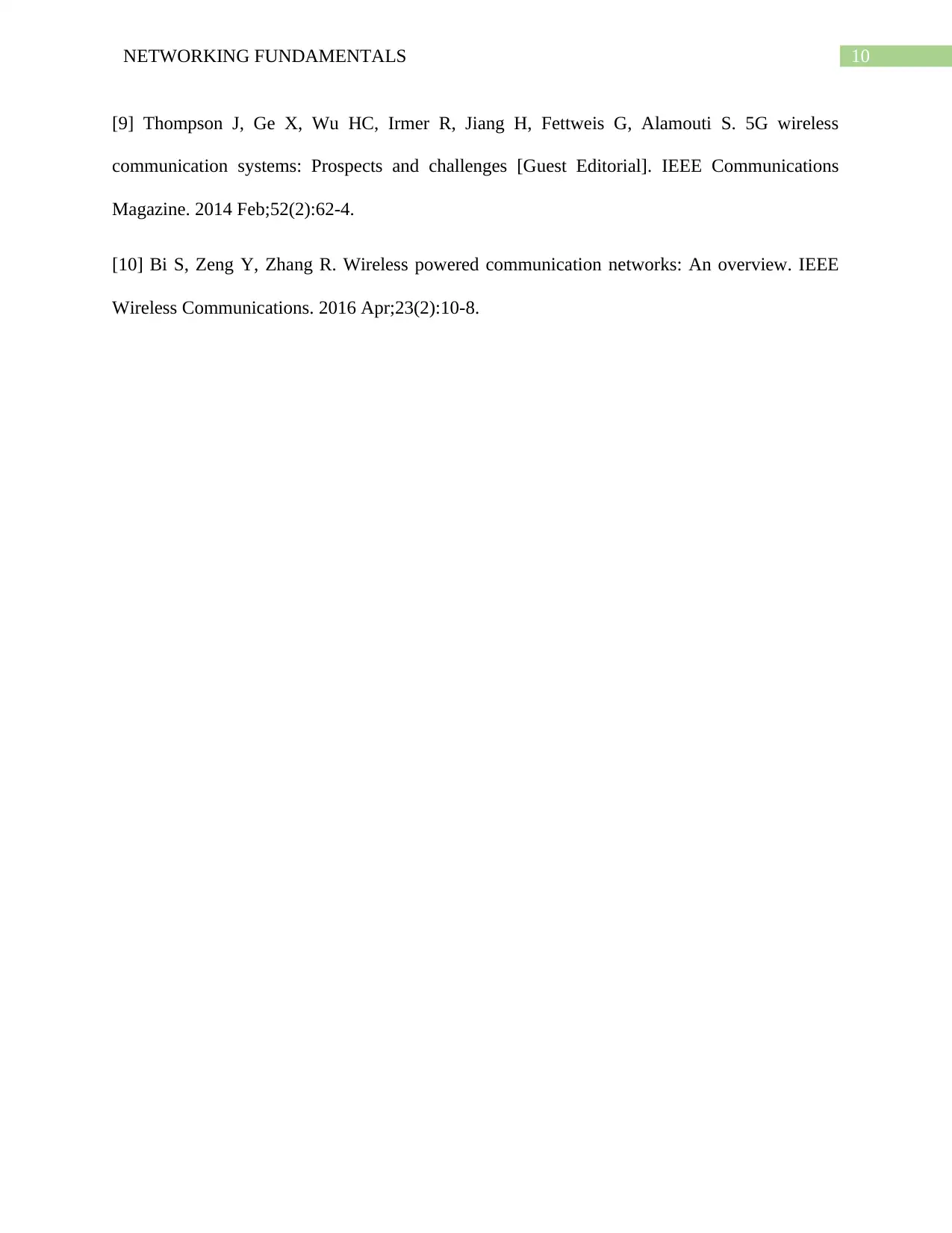
10NETWORKING FUNDAMENTALS
[9] Thompson J, Ge X, Wu HC, Irmer R, Jiang H, Fettweis G, Alamouti S. 5G wireless
communication systems: Prospects and challenges [Guest Editorial]. IEEE Communications
Magazine. 2014 Feb;52(2):62-4.
[10] Bi S, Zeng Y, Zhang R. Wireless powered communication networks: An overview. IEEE
Wireless Communications. 2016 Apr;23(2):10-8.
[9] Thompson J, Ge X, Wu HC, Irmer R, Jiang H, Fettweis G, Alamouti S. 5G wireless
communication systems: Prospects and challenges [Guest Editorial]. IEEE Communications
Magazine. 2014 Feb;52(2):62-4.
[10] Bi S, Zeng Y, Zhang R. Wireless powered communication networks: An overview. IEEE
Wireless Communications. 2016 Apr;23(2):10-8.
1 out of 10
Related Documents
Your All-in-One AI-Powered Toolkit for Academic Success.
+13062052269
info@desklib.com
Available 24*7 on WhatsApp / Email
![[object Object]](/_next/static/media/star-bottom.7253800d.svg)
Unlock your academic potential
Copyright © 2020–2025 A2Z Services. All Rights Reserved. Developed and managed by ZUCOL.




